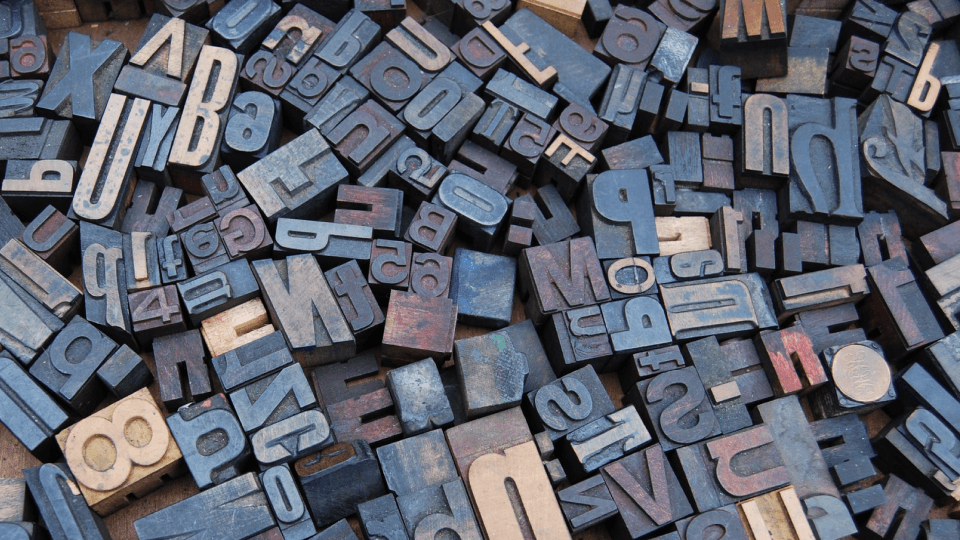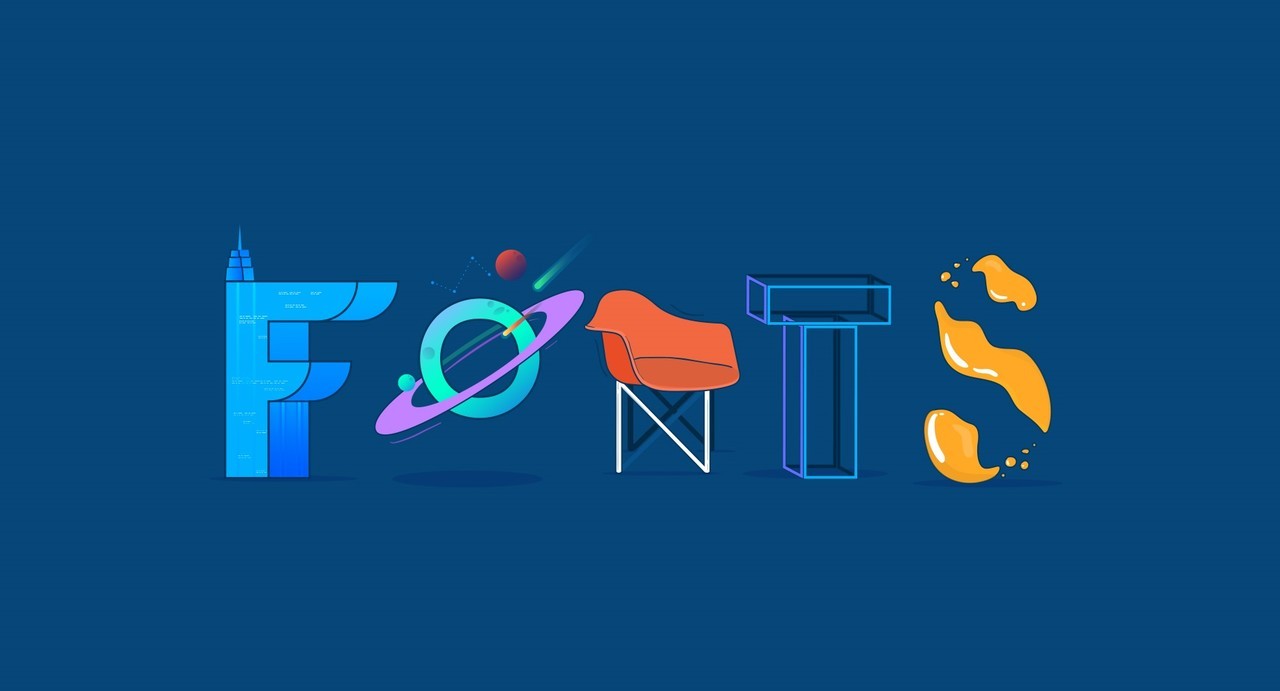Typography, the art of arranging letters, is a captivating skill that weaves visual harmony into every piece of design. In this fast-paced world, where attention spans are fleeting, typography holds the key to capturing and engaging audiences like never before.
A thoughtful selection of fonts can breathe life into your message, making it both captivating and easily comprehensible. Typography is crucial because it wields the power to visually communicate messages, evoke emotions, and enhance the overall user experience.
As an essential element of design, typography also plays a key role in capturing attention, conveying meaning, and leaving a lasting impact on audiences across various mediums. So, this is why typography is important.
Well, my fellow designers and writers, as you embark on your creative journey, remember that typography is not just a technical aspect but an art form that demands your passion and dedication. Understand its anatomy, harness its power, and let it transform your work into a masterpiece that resonates with your audience.
Table of Contents

Anatomy of Typography
Typography, like every other kind of art, has its own anatomy. Understanding typographic anatomy is critical for designers and writers who want to produce aesthetically beautiful and understandable content. The following are the essential parts that comprise typography’s anatomy:
- Baseline: The baseline is a line that the characters sit on. It is the basis for aligning and placing the text.
- X-Height: The x-height of a fonts is the height of the lowercase letter “x.” It is an important aspect in determining the overall legibility and readability of the text.
- Cap Height: The cap height of a font is the distance between the baseline and the top of the capital letters. It is critical for keeping capital letters consistent in look.
- Ascender: The section of a lowercase letter that extends above the x-height is known as the ascender. Ascending letters include “d,” “h,” and “l.”
- Descender: The descender is the lowercase letter part that extends below the baseline. Descendants exist for letters such as “g,” “p,” and “q.”
- Serif: Serifs are the small decorative strokes or lines at the end of the main strokes of some letters in serif fonts. They can be found on characters like “T,” “l,” and “e” in fonts like Times New Roman.
- Sans Serif: Sans-serif fonts lack serifs, and the strokes are usually uniform in width. Examples include Arial and Helvetica.
- Ligature: A ligature is a combination of two or more characters that are joined together to create a more aesthetically pleasing appearance. Common ligatures include “fi,” “fl,” and “ae.”
- Kerning: Kerning is the process of adjusting the spacing between individual characters to create more visually pleasing and consistent letter spacing.
- Tracking: Tracking refers to adjusting the overall spacing between letters, words, or lines of text. It helps control the density and readability of the text.
- Leading: Leading (pronounced “ledding”) is the vertical space between lines of text. Proper leading ensures adequate readability and prevents lines from crowding or overlapping.
- Baseline Shift: Baseline shift is a typographic adjustment where a character is moved up or down relative to the baseline. This is often used to create super- and subscripts.
- Point Size: The point size is the measurement of the height of a font’s characters. One point is equal to 1/72 of an inch.
- Italic: Italic typefaces are slanted versions of the regular font, providing emphasis or a distinctive appearance.
- Bold: Bold typefaces have thicker and darker strokes, used to create emphasis and visual contrast.
Essential Elements
Leading: Leading, pronounced as “ledding,” refers to the vertical space between lines of text. Proper leading ensures adequate readability and prevents lines from crowding or overlapping, contributing to an enjoyable reading experience.
Kerning: Kerning is the meticulous adjustment of spacing between individual characters to create visually pleasing and consistent letter spacing. By fine-tuning kerning, designers achieve a harmonious flow of text, enhancing overall readability.
Tracking: Tracking, unlike kerning, focuses on adjusting the overall spacing between letters, words, or lines of text. This typographic technique helps control the density and readability of the content, ensuring a visually balanced composition.
Orphan: An orphan, in typography, refers to a single word or very short line at the end of a paragraph, separated from the rest of the text. Eliminating orphans aids in maintaining a cohesive and visually appealing layout.
Understanding the anatomy of typography allows designers to make informed decisions about font choices, spacing, and alignment, resulting in visually appealing and easily readable designs with the role of leading, kerning, tracking, and addressing orphans within typography.
By mastering these elements, designers can effectively communicate their message and create a positive user experience for their audience. Also, you can use Midjourney (AI Art Platform) typography prompts to get outstanding results.

Types of Fonts in Typography
Typography includes a variety of font varieties, each with its own unique characteristics and uses. Serif typefaces are elegant due to their delicate ornamental strokes, but sans-serif fonts are contemporary and clean. Script typefaces provide refinement to projects by mimicking cursive handwriting, whilst display fonts make a dramatic statement with their ornamental flare.
Monospaced typefaces give code consistency, whereas handwritten fonts provide a personal touch. Decorative fonts include beautiful and one-of-a-kind styles that are perfect for specific design components. Knowing these font kinds enables designers to build visually engaging and meaningful experiences. Here are types of fonts with typography examples.
1. Sans-serif fonts
Sans-serif fonts are characterized by their clean lines and absence of serifs (the small lines or curves on the ends of letters). They are often used for digital designs, as they are easier to read on screens. Examples include Arial, Helvetica, and Verdana. One famous example of how sans-serif fonts can be used to enhance a message is the Obama campaign’s use of Gotham, which became synonymous with the brand.
2. Serif fonts
Serif fonts have small lines (serifs) on the ends of letters, giving them a more traditional feel. They are often used in print designs, such as books and newspapers. Examples include Times New Roman, Garamond, and Baskerville. A famous example of how serif fonts can be used is the masthead of The New York Times, which has used the same font (called TImes) since 1932.
3. Slab fonts
Slab fonts are characterized by their thick, bold lines and square serifs. They are often used for headlines and logos. Examples include Rockwell, Courier, and Press Gothic. A great example of how slab fonts can be used is the logo for American Apparel, which uses the font Helvetica Neue bold Condensed.
4. Monospace fonts
Monospace fonts have equal spacing between each character, regardless of the size of the letter, giving them a very mechanical look. They are often used for coding and programming. Examples include Courier, Consolas, and Lucida Console. A famous example of how monospace fonts can be used is the coding font used in the movie The Matrix
5. Display fonts
Display fonts are often used for titles or headlines and are meant to be bold and attention-grabbing. They come in various styles and shapes and can be used to convey different emotions or messages. Examples include Impact, Bodoni, and Futura. A great example of how display fonts can be used is the Coca-Cola logo, which uses the custom-designed font Spencerian Script.
6. Handwriting fonts
Handwriting fonts are designed to look like handwriting, often to convey a personal and informal touch. They are often used for invites, greeting cards, and personal letters. Examples include Pacifico, Tangerine, and Dancing Script. One famous example of how handwriting can be used is the Google logo, the letters of which were originally designed using the font Catull, which was hand-drawn.
The Different Elements of Typography
Fonts and Typefaces
Fonts and typefaces are the foundation of typography. Understanding the distinctions between serif, sans-serif, script, and display fonts allows designers to choose the most suitable options for their content and brand image.
Contrast
Effective use of contrast in typography can create visual interest and draw attention to key elements. Contrast in font size, weight, and style helps establish a hierarchy and guides users through the content flow.
Consistency
Maintaining consistency across a website’s typography fosters familiarity and reinforces brand identity. Consistent use of fonts, sizes, and colors establishes a cohesive and polished look.
White Space
Whitespace, or negative space, is the empty space around and within typographic elements. Skillful use of white space enhances readability, improves content organization, and contributes to a clean and modern design.
Alignment
Proper alignment of text elements ensures a professional and visually appealing layout. Aligning text left, right, center, or justified impacts the overall tone and style of the content.
Color
Color choices in typography can evoke emotions, create emphasis, and complement the overall design theme. Understanding color psychology is crucial in selecting appropriate hues for text.
Also Read: The Complete Guide to Color Theory And Its Application
Hierarchy
Establishing a typographic hierarchy helps users grasp the importance and sequence of information. Heading sizes, font styles, and formatting contribute to a clear hierarchy.

Hairline Typography: A Stylish Marvel in the World of Design
Hairline typography, also known as ultra-thin or delicate typography, is a captivating and elegant approach to lettering that captivates the eye and leaves a lasting impression. Crafted with the finest strokes, hairline typography exudes refinement and sophistication, elevating any design to new heights. This delicate art form is found in modern design aesthetics, particularly in minimalistic and high-end projects. When used correctly, hairline typography remains readable, requiring careful attention to detail and selecting the right typeface. It commands attention and admiration, transforming ordinary into extraordinary.

How to Choose the Correct Typeface for Your Website?
Picking the right typeface is an important choice that affects how your brand is portrayed. While selecting a typeface for your website, keep the following considerations in mind:
- Purpose: Identify the primary purpose of your website and its target audience. Different typefaces convey various emotions and aesthetics, so align the chosen typeface with your website’s goals.
- Rules for Readability: Ensure the chosen typeface is easily legible across different devices and screen sizes. Avoid overly decorative fonts that may hinder readability.
- Elements of Branding: Your typeface should align with your brand’s personality and image. A well-matched typeface reinforces brand recognition and consistency.
What is an orphan in typography?
Fellow designers, take note of the puzzling mystery of typographic orphans! These outliers – single words or brief lines left alone at the conclusion of a paragraph – interrupt our smooth flow. Let us aim for visual harmony, smoothly directing the eye through our language. Eliminate these lonely orphans with tricks at hand, guaranteeing our words dance in harmony, enchanting readers with typography’s charm.
Imagine a perfectly constructed paragraph, words flowing smoothly, seamlessly carrying the reader through the tale, only to come upon this lonesome orphan, adrift and estranged from its literary friends. Ah, the terror it brings to a nicely crafted piece’s aesthetics!
What is kinetic typography?
Kinetic typography is a dynamic and compelling method that uses motion to bring words and text to life. It is the skill of animating text in a way that increases the visual impact of the message and engages the audience’s attention.
The basic idea behind kinetic typography is to sync the movement with the audio or spoken words, resulting in a seamless fusion of text and sound. This synchronization increases the emotional effect of the communication and assists in expressing the proper tone, mood, or emphasis.

Why is Typography Important for Graphic Designers?
Graphic designers play a pivotal role in creating visually appealing content. Typography, as a core element of design, allows graphic designers to communicate effectively and artistically through their work. Understanding the principles of typography empowers designers to make informed decisions that elevate their creations.
Visual Communication
Typography is a powerful means of visual communication. It conveys messages, emotions, and ideas through the arrangement of typefaces, fonts, and styles. By choosing the right typography, designers can evoke specific moods and establish the intended tone of their designs.
Brand Identity
Consistent and well-chosen typography helps establish and reinforce brand identity. The typography used in a logo, marketing materials, and websites contributes to the recognition and memorability of a brand, fostering a strong and cohesive brand image.
Readability and User Experience
A well-executed typography enhances readability and user experience. By selecting legible typefaces and appropriate font sizes, designers ensure that users can easily consume the content without strain or confusion.
Visual Hierarchy
Typography aids in creating a visual hierarchy within a design. By varying font sizes, styles, and weights, designers can guide the viewers’ eyes through the content, highlighting essential information and organizing the layout effectively.
Emotional Impact
Different typefaces evoke different emotions and feelings. Serif fonts may convey tradition and elegance, while sans-serif fonts can communicate modernity and simplicity. Designers can leverage these emotional connections to align the typography with the intended message or product.
Message Emphasis
Typography allows designers to emphasize specific messages or elements within a design. Bold or italicized text draws attention to critical information, calls to action, or headlines, ensuring that the essential aspects stand out.
Legibility Across Devices
In today’s digital world, designs need to be responsive and adaptable to various devices and screen sizes. Typography choices impact how well the content renders on different platforms, ensuring a consistent experience for users.
Artistic Expression
Typography offers designers a creative outlet for artistic expression. Experimenting with different typefaces, layouts, and text treatments allows designers to craft unique and visually captivating designs.
Print and Digital Design Integration
Whether it’s print or digital design, typography plays a central role in both mediums. Understanding how to optimize typography for different formats allows designers to create cohesive branding experiences across various channels.
Attention to Detail
Typography demands precision and attention to detail. The proper spacing, kerning, and leading are vital to creating a polished and professional design that reflects the designer’s expertise.
Also Read: Designer’s Guide: Mastering Contrast, Hierarchy, Balance, and Movement

Typography Resources to Enhance Your Typography Journey
When it comes to the amazing world of typography, having access to quality resources may help you improve your creative skills and make more informed decisions. These are some resources to assist you better understand typography, ranging from books to internet references:
1. Amazon Books on Typography
- “The Elements of Typographic Style” by Robert Bringhurst: A timeless classic that delves deep into typographic principles, offering valuable insights for designers of all levels.
- “Thinking with Type” by Ellen Lupton: A practical guide that explores the fundamental concepts of typography and how to apply them in modern design projects.
- “Type Matters! The Rhetoricity of Letterforms” by Jim Williams: An engaging read that connects typography with communication and rhetoric, giving you a fresh perspective on its impact.
2. Online Typography References
- Typewolf (typewolf.com): An invaluable resource for font inspiration and pairings, offering guidance on creating harmonious typography combinations.
- Adobe Typekit (fonts.adobe.com): A curated collection of high-quality fonts from Adobe, suitable for various design applications.
3. Design Blogs and Websites
- Smashing Magazine (smashingmagazine.com): An authority in web design, offering in-depth articles on typography trends, best practices, and case studies.
- A List Apart (alistapart.com): A treasure trove of design-related content, including typography insights and techniques from industry experts.
4. Typography Courses
- LinkedIn Learning (linkedin.com/learning): Offers a range of typography courses taught by industry professionals, covering both beginner and advanced topics.
- Coursera (coursera.org): Provides comprehensive typography courses from leading universities and design institutions.
5. Online Communities
- Reddit r/Typography (reddit.com/r/typography): A vibrant community of typography enthusiasts sharing ideas, resources, and critiques.
- Designer News (designernews.co): A platform where designers discuss typography trends, tools, and techniques.
6. Font Pairings for Industries
Typography is a powerful design element that can significantly impact the overall look and feel of your creations. When used effectively, it can elevate your designs and create a sense of visual harmony that resonates with your audience.
Top 5 Fonts Pairings:
- Font Pairings for Real Estate Websites
- Font Pairings for Creative Agency Websites
- Font Pairings for Construction Websites
- Font Pairings for Medical Websites
- Font Pairings for Tech Websites
Conclusion
Congrats for getting this far in this lengthy tutorial. I like your dedication to learning about typography. Your recommendations will be considered to guarantee that this guide is constantly enhanced.
In the captivating world of web design, typography reigns supreme. Its influence on user experience, brand identity, and content readability cannot be underestimated. By embracing the art of fonts, contrast, consistency, and more, designers can wield typography’s power to craft exceptional online journeys. So, whether you’re a seasoned pro or an aspiring designer, remember, typography holds the key to unlocking extraordinary web experiences. Happy designing!
FAQs
What is leading in typography?
Leading, pronounced as “ledding,” refers to the vertical spacing between lines of text. Proper leading is essential to ensure adequate readability and prevent lines from crowding or overlapping, contributing to a clean and organized layout.
What is tracking in typography?
Tracking refers to adjusting the overall spacing between characters, words, or lines of text. By fine-tuning tracking, designers can control the density and readability of the text, ensuring a visually pleasing and consistent letter spacing.
What is kerning in typography?
Kerning is the process of adjusting the space between individual characters to create visually pleasing and consistent letter spacing. It involves adjusting the space between specific letter pairs to achieve a harmonious and balanced appearance in the text.
What is a widow in typography?
In typography, a widow refers to a single word or short line of text that appears alone at the end of a paragraph or column. It creates an undesirable visual gap, disrupting the flow and aesthetic appeal of the text.
What is the best typography software?
The choice of typography software depends on individual preferences and project requirements. Some popular typography software options include Adobe InDesign, Adobe Illustrator, and Sketch, each offering various tools and features for creating compelling typography designs.
How to learn typography?
Learning typography involves studying the principles of type design, experimenting with different fonts, and understanding how typography impacts design aesthetics and user experience. Engaging in typography courses, tutorials, and practical exercises can help aspiring designers master this skill.





